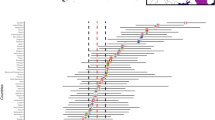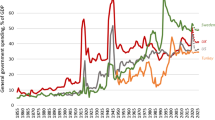Abstract
This exploratory study focuses on classifying attitudes toward institutional features of Individual Development Accounts (IDAs). The study also examines the extent to which attitudes change and how they are associated with saving in IDAs. While attitudes toward IDAs were generally positive, latent class analysis (LCA) found three groups at Wave 3: highly positive, moderately positive, and mixed opinion. The study found dynamic changes in attitudes at 18 months and 48 months after the baseline interview. While 63% of participants showed no changes in attitudes, 22% changed their attitudes negatively and 15% positively. Participants with highly positive attitudes at both 18 months and 48 months had significantly more savings than participants without highly positive attitudes, suggesting that attitudes may influence saving outcomes in IDAs.

Similar content being viewed by others
References
Bergman, L. R., & Magnusson, D. (1997). A person-oriented approach in research on developmental psychopathology. Development and Psychopathology, 9, 291–319.
Beverly, S. G., & Sherraden, M. (1999). Institutional determinants of saving: Implications for low-income households and public policy. Journal of Socio-Economics, 28, 457–473.
Caner, A., & Wolff, E. N. (2004). Asset poverty in the United States: Its persistence in an expansionary economy (Public Policy Brief No. 76). Annandale-on-Hudson, New York: The Levy Economics Institute of Bard College.
Clancy, M., Han, C., Mason, L. R., & Sherraden, M. (2006). Inclusion in college savings plans: Participation and saving in Maine’s matching grant program (CSD Research Report 06-03). St. Louis, MO: Washington University, Center for Social Development.
Curley, J., Ssewamala, F., & Sherraden, M. (2005). Institutions and savings in low-income households (CSD Working Paper No. 05–13). St. Louis, MO: Washington University, Center for Social Development.
Dew, J. (2007). Two sides of the same coin? The differing roles of assets and consumer debt in marriage. Journal of Family and Economic Issues, 28, 89–104.
Dew, J. (2009). The gendered meanings of assets for divorce. Journal of Family and Economic Issues, 30, 20–31.
Edwards, K., & Mason, L. M. (2003). State policy trends for Individual Development Accounts in the United States: 1993–2003 (CSD Policy Report). St. Louis, MO: Washington University, Center for Social Development.
Fletcher, C. N., Garasky, S., & Nielsen, R. B. (2005). Transportation hardship: Are you better off with a car? Journal of Family and Economic Issues, 26, 323–343.
Fry, T. R. L., Mihajilo, S., Russell, R., & Brooks, R. (2008). The factors influencing saving in a matched savings program: Goals, knowledge of payment instruments, and other behavior. Journal of Family and Economic Issues, 29, 234–250.
Gudmunson, C. G., Beutler, I. F., Israelsen, C. L., McCoy, J. K., & Hill, E. J. (2007). Linking financial strain to marital instability: Examining the roles of emotional distress and marital interaction. Journal of Family and Economic Issues, 28, 357–376.
Han, C. (2006). Saving in individual development accounts: Latent growth curve modeling (CSD Working Paper No. 06–17). St. Louis, MO: Washington University, Center for Social Development.
Haynes-Bordas, R., Kiss, D. E., & Yilmazer, T. (2008). Effectiveness of financial education on financial management behavior and account usage: Evidence from a ‘Second Chance’ program. Journal of Family and Economic Issues, 29, 362–390.
Kass, R., & Wasserman, L. (1995). A reference Bayesian test for nested hypotheses and its relationship to the Schwartz criterion. Journal of American Statistical Association, 90, 928–934.
Lusardi, A. (2003). The impact of financial education on savings and assets (Working Paper wp061). Ann Arbor, MI: University of Michigan, Michigan Retirement Research Center.
Madrian, B. C., & Shea, D. F. (2001). The power of suggestion: Inertia in 401(k) participation and savings behavior. Quarterly Journal of Economics, 116, 1149–1187.
Mason, L. R., Clancy, M., Sherraden, M., & Han, C. (2006). Saving for college in Maine’s matching grant program: Account owner experiences (CSD Research Report 06-04). St. Louis, MO: Washington University, Center for Social Development.
McCutcheon, A. L. (1987). Latent class analysis (Sage University Paper Series on Quantitative Applications in the Social Sciences No. 07–064). Newberry Park, CA: Sage.
Munnell, A. H., Sunden, A., & Taylor, C. (2002). What determines 401(k) participation and contributions? Social Security Bulletin, 64(3), 64–76.
Muthēn, B., & Muthēn, L. K. (2000). Integrating person-centered and variable-centered analyses: Growth mixture modeling with latent trajectory classes. Alcoholism, Clinical and Experimental Research, 24(6), 882–891.
O’Neill, B. (2007). Overcoming inertia: Do automated saving and investing strategies work? Journal of Family and Economic Issues, 28, 321–335.
Parks-Yancy, R., DiTomaso, N., & Post, C. (2007). The mitigating effects of social and financial capital resources on hardships. Journal of Family and Economic Issues, 28, 429–448.
Peng, T. M., Bartholomae, S., Fox, J. J., & Cravener, G. (2007). The impact of personal finance education delivered in high school and college courses. Journal of Family and Economic Issues, 28, 265–284.
Schreiner, M., Clancy, M., & Sherraden, M. (2002). Saving performance in the American Dream Demonstration: A national demonstration of Individual Development Accounts (CSD Report). St. Louis, MO: Washington University, Center for Social Development.
Schreiner, M., & Sherraden, M. (2007). Can the poor save? Savings and asset building in Individual Development Accounts. New Brunswick, NJ: Transaction.
Sherraden, M. (1991). Assets and the poor: A new American welfare policy. Armonk, NY: M.E. Sharpe.
Sherraden, M. S., McBride, A. M., Johnson, E., Hanson, S., Ssewamala, F. M., & Shanks, T. R. (2005). Saving in low-income households: Evidence from interviews with participants in the American Dream Demonstration (CSD Report 05-02). St. Louis, MO: Washington University, Center for Social Development.
Ssewamala, F. M., & Sherraden, M. S. (2004). Integrating saving into microenterprise programs for the poor: Do institutions matter? Social Service Review, 78, 404–428.
Wakita, S., Fitzsimmons, V. S., & Liao, T. F. (2000). Wealth: Determinants of savings net worth and housing net worth of pre-retired households. Journal of Family and Economic Issues, 21, 387–418.
Xiao, J. J., & Anderson, J. G. (1997). Hierarchical financial needs reflected by household financial asset shares. Journal of Family and Economic Issues, 18, 333–355.
Yamaguchi, K. (2000). Multinomial logit latent-class regression models: An analysis of the predictors of gender-role attitudes among Japanese Women. American Journal of Sociology, 105, 1702–1740.
Yilmazer, T. (2008). Saving for children’s college education: An empirical analysis of the trade-off between the quality and quantity of children. Journal of Family and Economic Issues, 29, 307–324.
Acknowledgments
The authors would like to thank the following foundations for support of this article: the Ford Foundation, Charles Stewart Mott Foundation, FB Heron Foundation, and Metropolitan Life Foundation for funding the American Dream Demonstration (ADD); the Corporation for Enterprise Development for implementing the ADD; the Center for Social Development for managing research projects and monitoring data. We also thank Julia Stevens and Carrie Freeman for editing the paper. In addition, we appreciate valuable comments from the editor and two anonymous reviewers.
Author information
Authors and Affiliations
Corresponding author
Rights and permissions
About this article
Cite this article
Han, CK., Sherraden, M. Attitudes and Saving in Individual Development Accounts: Latent Class Analysis. J Fam Econ Iss 30, 226–236 (2009). https://doi.org/10.1007/s10834-009-9157-8
Published:
Issue Date:
DOI: https://doi.org/10.1007/s10834-009-9157-8




